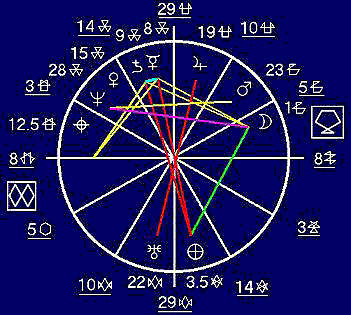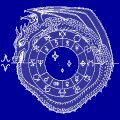Galactic Astrology : Example Chart
Albert Einstein: Galactic chart
Born on 14th March 1879 at 11.30 a.m. LMT in Ulm, Germany (48N24, 10E00),
Einstein became the most significant scientist since Newton contributing to
several areas of modern physics, although he is known mainly for his work on
Relativity.
His search for the Unified Field Theory (a single theory explaining all the
interactions between particles or forces) was not fulfilled and still taxes
theoretical physicists today. Towards the end of his life he had difficulty
accepting all the changes in physics his theories had lead to, particularly the Heisenberg Uncertainty Principle because he could not believe the universe is governed entirely by chance, "God may be subtle," he once said, "but He is not malicious".
Apart from his scientific works, Einstein wrote several pamphlets and papers upholding the right and dignity of man. He was a champion of the poor and an ardent pacifist (but urged President Roosevelt to develop the atom bomb before Hitler). He had strong religious and philosophical interests, coloured by universal and humanitarian principles, "...the cosmic religious experience is the strongest and the noblest mainspring of scientific research" and "to know that what is impenetrable manifesting itself as the highest wisdom and the most radiant beauty is at the centre of true religiousness".
Einstein believed it was impossible to separate the physical and metaphysical; the philosophy of Spinoza stimulated his concern for the
relationship between energy and matter, "In Spinoza, one finds the majestic
concept that thinking [the soul] and extension [the naturalistically conceived world] are only different forms of appearance of the same 'substance'."
 |
|
His Galactic chart is dominated by the opposition between the Mercury-Saturn conjunction and the Earth. With the Earth in the sign Teach and the house of Construction & Demolition he would be seen as someone who demonstrated how to lay the foundations for something new, perhaps demolishing the old in the process and many followed his lead, developing his theories to the extent that even the nature of reality itself is questioned. But the Saturn-Mercury conjunction suggests he was aiming in a different direction, that he was primarily concerned with learning and teaching fundamental structures. Mercury in Build suggests the kind of connections he would make were concerned with underlying patterns or blueprints. It shows he was alive to the possibilities of formalising that were presented to him and, with Saturn involved, these would become a major aim and attachment in life. The Moon eases this opposition suggesting he was aware of the tension created by the role he had chosen and the effects it would have. In the sign Explore and the house of Health & Illness he sought to go beyond the familiar with a view towards making a wholeness, finding a more complete picture (the Unified Field Theory ?) Yet, the square to Neptune would inhibit his possibilities; it implies he would define himself more as the healing explorer.
The Ascendant sign, Collect, indicates Einstein's major lesson in life had to do with harvesting, reaping what he had sown. The close sextile to
Mercury-Saturn also suggests his 'karma' was strongly related to the structures he perceived and to which he was attached. It is intriguing that he rejected some of the developments arising from his work and as a pacifist, that he was partly responsible for the atom bomb.
D.C.
(Birth details and quotes from "Draconic Astrology", Pamela Crane)
[Top]
© The Astrological Society






